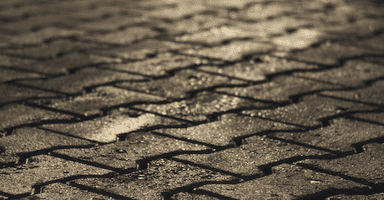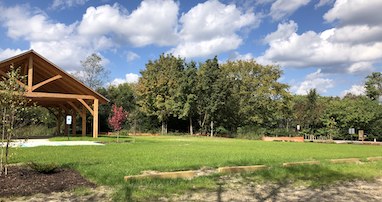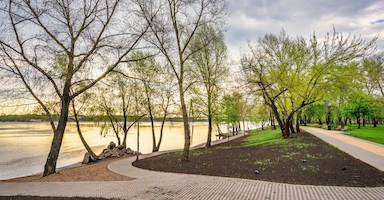28 MaySustainable Landscaping: What, Why and How to Start

What is sustainable landscaping?
Defined simply, sustainable landscaping is a modern way of gardening or landscaping that seeks to put the environment first with minimal use of non-renewable resources.
Sustainable landscaping goes hand in hand with green infrastructure. Both stormwater strategies supplement man made infrastructure with environmentally friendly choices. Sustainable landscaping and green infrastructure can both be incorporated into your home or development with minimal effort.
Why try sustainable landscaping?
Traditional landscape practices focus on ornamental value. Sustainable landscaping, on the other hand, encourages self-sustaining mindful choices that minimize environmental impact.
When mismanaged, traditional landscaping can result in water pollution, water shortages and poor soil health.
Communities are becoming more interested and invested in adopting sustainable practices. As homeowners and businesses become more conscious of their environmental impact, adapting their landscaping strategy is a simple way to make a more environmentally friendly choice.
Making the switch to sustainable landscaping
Environmentally conscious landscape professionals and homeowners can implement sustainable practices to mitigate climate change and promote resilience.
The goal should be to create a natural system that can withstand and adapt to our changing environment. Design, construction, and management of sustainable landscapes will reduce our climate footprint.
There are many simple steps that landscapers and homeowners can take to implement sustainable landscape ideas. You will find they are easy and best of all save time and money.
Evaluate your landscape and make a plan
Before you start making any adjustments, look around your yard. Ask yourself, what do you want from your outdoor life?
- Do you want to garden?
- Do you want to grow flowers and vegetables?
- Do you want to entertain or play with the kids?
- What issues does your yard currently have?
- Are there flood zones, erosion areas, and plants that need a lot of care and watering?
The answers to these questions will steer you to the best place to start.
You can start slow and small. Expand a current mulch bed or start with just a small section of your yard instead of the entire landscape.
Once you know what you want, start implementing the following sustainable landscaping ideas.
Plant vegetation and maintain healthy soil
Trees, plants, and flowers are critical to our urban and suburban communities. They absorb CO2, prevent erosion, attract, and feed pollinators.
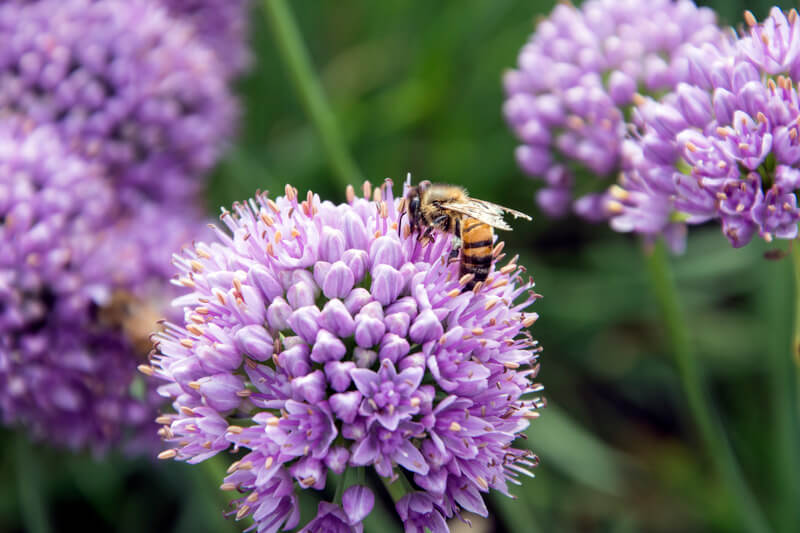
Just because traditional landscaping focuses on ornamental and sustainable focuses on the environment, does not mean you have to sacrifice aesthetics. Planting more trees, plants and flowers has a positive environmental and aesthetic impact.
Even if you only have a small space to landscape, you can grow plants in pots for decks and porches.
If you have more space to work with, incorporate trees for design and privacy.
Trees have many benefits and are the cornerstone of sustainable landscaping.
Trees and healthy soil are important for carbon sequestration. Trees prevent CO2 from releasing into the atmosphere and hence reduce greenhouse gases. Also, higher CO2 levels in the atmosphere can lead to the proliferation of weeds and invasive plants.
Trees can absorb as much as 48 pounds of CO2 per year. They also provide shelter for birds, mammals, and insects. Trees are natural windbreaks and are microclimates that reduce temperatures and add oxygen and moisture to the air.
When you begin to add vegetation start with trees, then add shrubs, perennials and grass. This is considered the optimal order for carbon removal.
It is important to maintain healthy soil because soil stores more than three times the amount of carbon stored in the atmosphere. Soil disturbance releases carbon into the atmosphere so make a conscious choice to reduce excessive tilling and excavation. This will also reduce erosion.
Plant native plants and remove invasive plants
Native plants are uniquely suited for the local area and therefore naturally require less maintenance. These plants have adapted to the local climate and will provide a vital habitat for local bees, birds, and insects.
Source native plants locally. Locally grown plants restore our natural communities, protect our habitats, and support adaptive genetic diversity.
Avoid and remove invasive plants. Invasive plants can quickly steal growing space from native ones. Common examples of invasive plants are English Ivy, Burning Bush, and Bradford Pears.
Lastly, remove plants in your landscape areas that require too much maintenance such as water, pesticide, or fertilizers. Replace them with hardier native varieties.
Conserve Water
We can all make an effort to be more conscious of our water consumption, specifically for outdoor use.
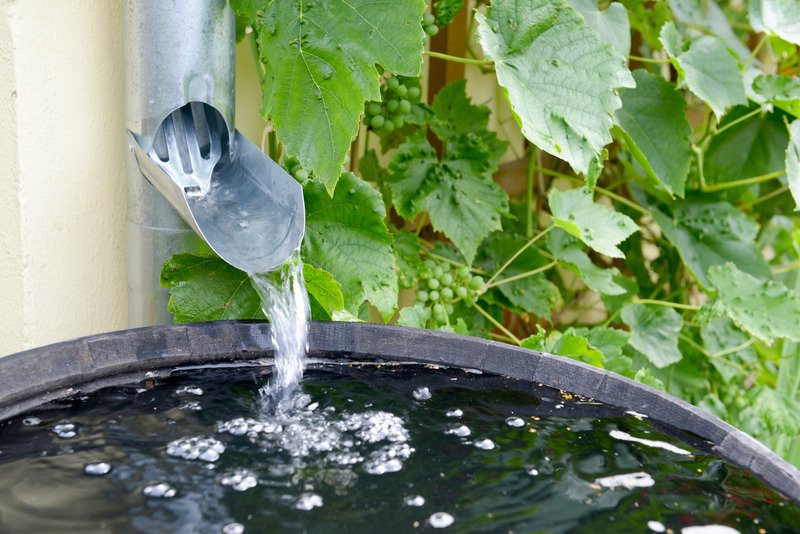
Collect rainwater from roof runoff into a rain barrel for landscape watering.
If you have irrigation, check the heads frequently for leaks and spout direction. Make sure that it is watering the area and not spraying the street or driveway. Consider installing a rain sensor that will shut off the irrigation when it rains.
Try to manage water on site. Create rain gardens, reduce impervious surfaces, and select drought resistant plants that do not require a lot of water.
Fertilize Minimally
Reduce the use of fertilizers and switch to organic types. Use the specified amounts at the right time of year and do not over apply. Sweep or blow any excess fertilizer from the driveway or street to the yard in order to prevent it from making its way to the aquifer.
Reduce Grass Area
In your yard evaluation did you find that a smaller grass area was sufficient for your needs? Match your lawn to meet your requirements. If grass is not a priority for you, eliminate it. Grass offers few environmental advantages for wildlife while requiring a substantial amount of time, money, and energy.
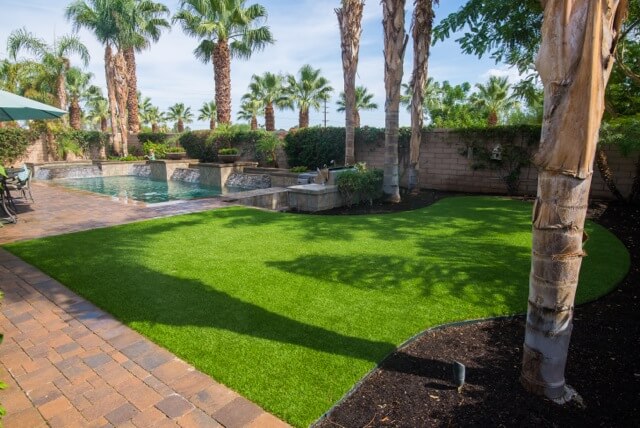
Consider lawn substitutes such as synthetic turf. While it represents an initial upfront investment, the long- range return on time, money and environmental impact is worth it.
Recycle, Compost and Grasscycle
Did you know you should leave grass clipping on your lawn after you mow? As the clippings decay, they return nutrients back to the soil. Leaving your grass clippings in your lawn also
- decreases the amount of fertilizer you need for your lawn by a fourth to a third
- reduces landfill waste
- saves you time and effort.
If you still have excess clippings, add them to a compost bin which will deliver healthy composted soil for your landscape beds or garden.
Keep grass trimmed to 2 to 3 inches in order to protect the root system. Water only once a week if rainfall in less than one inch. Use organic fertilizers only once per year in the fall.
Enjoy your sustainable landscape
Creating a sustainable landscape can bring joy and pride to you and your family. There are positive personal health benefits to be gained from natural environmental approaches. Small steps can be taken by all of us to reduce our personal carbon footprint and save our planet.
Contact our sales team if you would like to receive pricing on sustainable products.
Discover More Green Solutions
Permeable Paving Solutions
Managing stormwater is a critical concern for municipalities, engineers and developers. As our communities grow…
Green Parking Case Study
Before you can build a road or parking lot you have to start with a…
Green Infrastructure Solutions and Benefits
What is Green Infrastructure? Throughout our country, cities are implementing environmentally sustainable solutions to manage…


